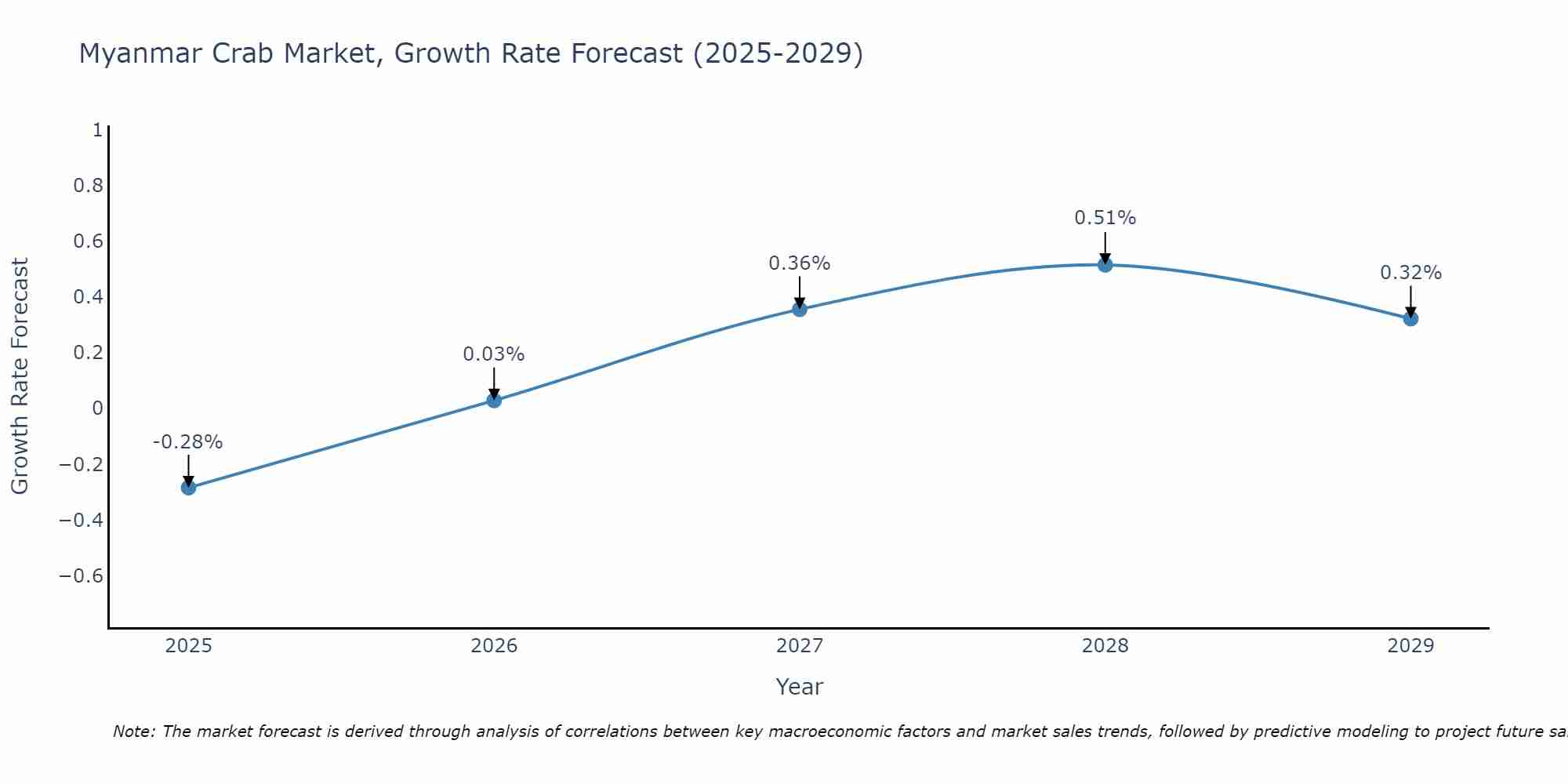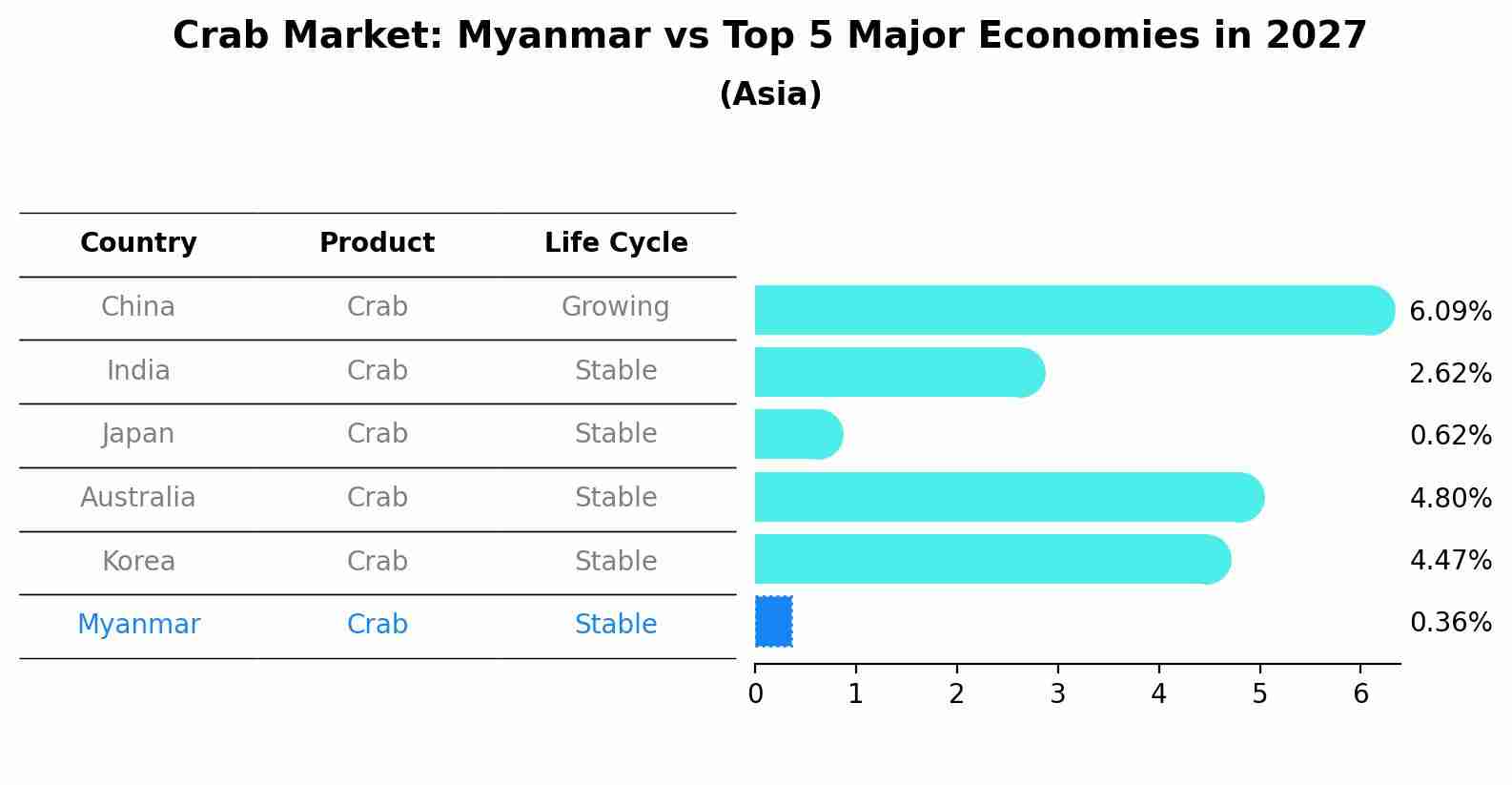Myanmar Crab Market Outlook | Share, Revenue, Growth, Companies, Size, Trends, Analysis, Forecast, Industry, Value & COVID-19 IMPACT
| Product Code: ETC088853 | Publication Date: Jun 2021 | Updated Date: Jun 2025 | Product Type: Report | |
| Publisher: 6Wresearch | Author: Summon Dutta | No. of Pages: 70 | No. of Figures: 35 | No. of Tables: 5 |
Myanmar Crab Market Size Growth Rate
The Myanmar Crab Market is projected to witness mixed growth rate patterns during 2025 to 2029. Starting at -0.28% in 2025, the market peaks at 0.51% in 2028, and settles at 0.32% by 2029.

Crab Market: Myanmar vs Top 5 Major Economies in 2027 (Asia)
By 2027, Myanmar's Crab market is forecasted to achieve a stable growth rate of 0.36%, with China leading the Asia region, followed by India, Japan, Australia and South Korea.

Myanmar Crab Market Overview
The Myanmar Crab Market is a growing sector within the country`s seafood industry, driven by domestic consumption and export demand. The market primarily consists of blue swimming crabs, mud crabs, and other varieties, with a significant portion of production coming from coastal regions such as Yangon, Ayeyarwady, and Rakhine. Crab farming and wild capture are the primary methods of sourcing crabs, with a focus on sustainable practices to ensure long-term viability. The market faces challenges such as inconsistent quality standards, limited infrastructure, and issues related to overfishing and habitat destruction. However, efforts are being made to address these issues through improved regulations, technology adoption, and market development initiatives to enhance competitiveness and meet international standards for exports to countries like China, Japan, and Singapore.
Myanmar Crab Market Trends
The Myanmar Crab Market is witnessing a growing demand for premium quality crabs, particularly among urban consumers and tourists. There is a shift towards sustainable and eco-friendly crab fishing practices, driven by increasing awareness about environmental conservation. Export opportunities are also expanding, with Myanmar crabs gaining popularity in international markets due to their unique taste and quality. The market is seeing innovation in packaging and processing technologies to ensure freshness and shelf life. Additionally, there is a rising trend in the establishment of crab farms to meet the growing demand and reduce pressure on wild crab populations. Overall, the Myanmar Crab Market is evolving to cater to the changing preferences of consumers while also focusing on sustainability and quality.
Myanmar Crab Market Challenges
In the Myanmar Crab Market, one of the main challenges faced is the lack of infrastructure and technology to support efficient processing and distribution of crab products. This results in difficulties in maintaining product quality and freshness, leading to potential losses for both suppliers and buyers. Additionally, there are concerns about sustainability practices and overfishing, which could impact the long-term availability of crabs in the region. Market access and regulatory issues, such as inconsistent enforcement of quality standards and export restrictions, also pose challenges for businesses operating in the Myanmar Crab Market. Overall, addressing these challenges would require investments in infrastructure, technology, and sustainable fishing practices, as well as improved regulatory frameworks to support the growth and competitiveness of the crab market in Myanmar.
Myanmar Crab Market Investment Opportunities
The Myanmar Crab Market presents promising investment opportunities due to increasing demand for seafood exports and the country`s strategic location in Southeast Asia. With its extensive coastline and diverse crab species, Myanmar has the potential to become a major player in the global crab market. Investors can consider opportunities in crab farming, processing facilities, and export channels to capitalize on the growing demand for high-quality seafood products. Government initiatives to improve infrastructure and support the aquaculture industry further enhance the investment potential in the Myanmar Crab Market. However, it is essential for investors to conduct thorough market research, assess risks related to regulations and sustainability practices, and establish strong partnerships with local stakeholders to ensure a successful and sustainable investment venture in the Myanmar Crab Market.
Myanmar Crab Market Government Policy
Government policies related to the Myanmar Crab Market focus on sustainability and conservation efforts to protect the crab population and ensure long-term viability of the industry. The government has implemented regulations on crab harvesting seasons, catch limits, and minimum size requirements to prevent overfishing and protect juvenile crabs. Additionally, there are restrictions on the use of certain fishing gear and methods to minimize environmental impact and preserve crab habitats. The government also supports initiatives to promote responsible fishing practices and increase market access for crab farmers and fishermen. Overall, these policies aim to balance economic interests with environmental concerns to sustainably manage the Myanmar Crab Market for future generations.
Myanmar Crab Market Future Outlook
The future outlook for the Myanmar Crab Market appears promising due to a growing demand for seafood both domestically and internationally, coupled with improving infrastructure and technology in the country. With Myanmar`s strategic location and abundant marine resources, the crab market is poised for growth in the coming years. Additionally, as consumers increasingly seek sustainable and high-quality seafood products, there is an opportunity for Myanmar to position itself as a reliable source of premium crabs. However, challenges such as environmental concerns, competition from other crab-producing countries, and potential regulatory changes may impact the market dynamics. Overall, with the right strategies in place to address these challenges and capitalize on the opportunities, the Myanmar Crab Market has the potential for steady expansion and profitability in the future.
Key Highlights of the Report:
- Myanmar Crab Market Outlook
- Market Size of Myanmar Crab Market, 2021
- Forecast of Myanmar Crab Market, 2027
- Historical Data and Forecast of Myanmar Crab Revenues & Volume for the Period 2018 - 2027
- Myanmar Crab Market Trend Evolution
- Myanmar Crab Market Drivers and Challenges
- Myanmar Crab Price Trends
- Myanmar Crab Porter's Five Forces
- Myanmar Crab Industry Life Cycle
- Historical Data and Forecast of Myanmar Crab Market Revenues & Volume By Type for the Period 2018 - 2027
- Historical Data and Forecast of Myanmar Crab Market Revenues & Volume By Blue Crab for the Period 2018 - 2027
- Historical Data and Forecast of Myanmar Crab Market Revenues & Volume By Chinese Mitten Crab for the Period 2018 - 2027
- Historical Data and Forecast of Myanmar Crab Market Revenues & Volume By Gazami Crab for the Period 2018 - 2027
- Historical Data and Forecast of Myanmar Crab Market Revenues & Volume By Others for the Period 2018 - 2027
- Historical Data and Forecast of Myanmar Crab Market Revenues & Volume By Form for the Period 2018 - 2027
- Historical Data and Forecast of Myanmar Crab Market Revenues & Volume By Frozen for the Period 2018 - 2027
- Historical Data and Forecast of Myanmar Crab Market Revenues & Volume By Canned for the Period 2018 - 2027
- Historical Data and Forecast of Myanmar Crab Market Revenues & Volume By Others for the Period 2018 - 2027
- Myanmar Crab Import Export Trade Statistics
- Market Opportunity Assessment By Type
- Market Opportunity Assessment By Form
- Myanmar Crab Top Companies Market Share
- Myanmar Crab Competitive Benchmarking By Technical and Operational Parameters
- Myanmar Crab Company Profiles
- Myanmar Crab Key Strategic Recommendations
Frequently Asked Questions About the Market Study (FAQs):
1 Executive Summary |
2 Introduction |
2.1 Key Highlights of the Report |
2.2 Report Description |
2.3 Market Scope & Segmentation |
2.4 Research Methodology |
2.5 Assumptions |
3 Myanmar Crab Market Overview |
3.1 Myanmar Country Macro Economic Indicators |
3.2 Myanmar Crab Market Revenues & Volume, 2021 & 2027F |
3.3 Myanmar Crab Market - Industry Life Cycle |
3.4 Myanmar Crab Market - Porter's Five Forces |
3.5 Myanmar Crab Market Revenues & Volume Share, By Type, 2021 & 2027F |
3.6 Myanmar Crab Market Revenues & Volume Share, By Form, 2021 & 2027F |
4 Myanmar Crab Market Dynamics |
4.1 Impact Analysis |
4.2 Market Drivers |
4.3 Market Restraints |
5 Myanmar Crab Market Trends |
6 Myanmar Crab Market, By Types |
6.1 Myanmar Crab Market, By Type |
6.1.1 Overview and Analysis |
6.1.2 Myanmar Crab Market Revenues & Volume, By Type, 2018 - 2027F |
6.1.3 Myanmar Crab Market Revenues & Volume, By Blue Crab, 2018 - 2027F |
6.1.4 Myanmar Crab Market Revenues & Volume, By Chinese Mitten Crab, 2018 - 2027F |
6.1.5 Myanmar Crab Market Revenues & Volume, By Gazami Crab, 2018 - 2027F |
6.1.6 Myanmar Crab Market Revenues & Volume, By Others, 2018 - 2027F |
6.2 Myanmar Crab Market, By Form |
6.2.1 Overview and Analysis |
6.2.2 Myanmar Crab Market Revenues & Volume, By Frozen, 2018 - 2027F |
6.2.3 Myanmar Crab Market Revenues & Volume, By Canned, 2018 - 2027F |
6.2.4 Myanmar Crab Market Revenues & Volume, By Others, 2018 - 2027F |
7 Myanmar Crab Market Import-Export Trade Statistics |
7.1 Myanmar Crab Market Export to Major Countries |
7.2 Myanmar Crab Market Imports from Major Countries |
8 Myanmar Crab Market Key Performance Indicators |
9 Myanmar Crab Market - Opportunity Assessment |
9.1 Myanmar Crab Market Opportunity Assessment, By Type, 2021 & 2027F |
9.2 Myanmar Crab Market Opportunity Assessment, By Form, 2021 & 2027F |
10 Myanmar Crab Market - Competitive Landscape |
10.1 Myanmar Crab Market Revenue Share, By Companies, 2021 |
10.2 Myanmar Crab Market Competitive Benchmarking, By Operating and Technical Parameters |
11 Company Profiles |
12 Recommendations |
13 Disclaimer |
- Single User License$ 1,995
- Department License$ 2,400
- Site License$ 3,120
- Global License$ 3,795
Search
Thought Leadership and Analyst Meet
Our Clients
Related Reports
- Afghanistan Apparel Market (2026-2032) | Growth, Outlook, Industry, Segmentation, Forecast, Size, Companies, Trends, Value, Share, Analysis & Revenue
- Canada Oil and Gas Market (2026-2032) | Share, Segmentation, Value, Industry, Trends, Forecast, Analysis, Size & Revenue, Growth, Competitive Landscape, Outlook, Companies
- Germany Breakfast Food Market (2026-2032) | Industry, Share, Growth, Size, Companies, Value, Analysis, Revenue, Trends, Forecast & Outlook
- Australia Briquette Market (2025-2031) | Growth, Size, Revenue, Forecast, Analysis, Trends, Value, Share, Industry & Companies
- Vietnam System Integrator Market (2025-2031) | Size, Companies, Analysis, Industry, Value, Forecast, Growth, Trends, Revenue & Share
- ASEAN and Thailand Brain Health Supplements Market (2025-2031) | Strategy, Consumer Insights, Analysis, Investment Trends, Opportunities, Growth, Size, Share, Industry, Revenue, Segments, Value, Segmentation, Supply, Forecast, Restraints, Outlook, Competition, Drivers, Trends, Demand, Pricing Analysis, Competitive, Strategic Insights, Companies, Challenges
- ASEAN Bearings Market (2025-2031) | Strategy, Consumer Insights, Analysis, Investment Trends, Opportunities, Growth, Size, Share, Industry, Revenue, Segments, Value, Segmentation, Supply, Forecast, Restraints, Outlook, Competition, Drivers, Trends, Demand, Pricing Analysis, Competitive, Strategic Insights, Companies, Challenges
- Europe Flooring Market (2025-2031) | Outlook, Share, Industry, Trends, Forecast, Companies, Revenue, Size, Analysis, Growth & Value
- Saudi Arabia Manlift Market (2025-2031) | Outlook, Size, Growth, Trends, Companies, Industry, Revenue, Value, Share, Forecast & Analysis
- Uganda Excavator, Crane, and Wheel Loaders Market (2025-2031) | Strategy, Consumer Insights, Analysis, Investment Trends, Opportunities, Growth, Size, Share, Industry, Revenue, Segments, Value, Segmentation, Supply, Forecast, Restraints, Outlook, Competition, Drivers, Trends, Demand, Pricing Analysis, Competitive, Strategic Insights, Companies, Challenges
Industry Events and Analyst Meet
Whitepaper
- Middle East & Africa Commercial Security Market Click here to view more.
- Middle East & Africa Fire Safety Systems & Equipment Market Click here to view more.
- GCC Drone Market Click here to view more.
- Middle East Lighting Fixture Market Click here to view more.
- GCC Physical & Perimeter Security Market Click here to view more.
6WResearch In News
- Doha a strategic location for EV manufacturing hub: IPA Qatar
- Demand for luxury TVs surging in the GCC, says Samsung
- Empowering Growth: The Thriving Journey of Bangladesh’s Cable Industry
- Demand for luxury TVs surging in the GCC, says Samsung
- Video call with a traditional healer? Once unthinkable, it’s now common in South Africa
- Intelligent Buildings To Smooth GCC’s Path To Net Zero


















